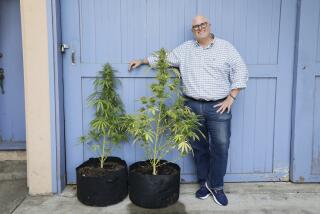GARDENING : How to Tell When It’s Harvest Time
- Share via
PHOENIX — Horticulturist Boyce Foerman believes the best qualities of home-grown vegetables are lost unless they are harvested at the best time.
So how do you determine when to pick them?
“It’s not easy, of course, but to me being able to determine prime quality of vegetables is just as important as developing the skill to grow them,” Foerman says. “And even if you don’t grow your own, being able to determine prime quality still is a worthwhile skill for everyone who buys vegetables at a market.”
A Purdue University graduate who retired in 1984 after 30 years with the University of Arizona, Foerman offers these general guidelines:
--Leafy vegetables: Look for bright color, firmness, tenderness and crispness.
“You want harvesting at the peak of vigor, before there is any maturing or slowing of growth,” he says. “That can be difficult to determine, because every leaf is going to have its individual time. But the toughness and bitter taste isn’t present until maturity starts. I think the main clue is color. Good, vigorously growing leaf tissue is not exactly a pale green, but it is a lighter green, and it darkens as it becomes mature.”
In the garden, Foerman suggests studying the growth pattern “and when leaves stop enlarging, or start staying about the same, that’s the time to harvest.”
--Leafy head vegetables: “It’s pretty much the same. When enlargement of the head ceases, then it’s probably at its peak,” he says. “Ideal cabbage heads should be firm yet yield to gentle pressure.”
--Flower-bud vegetables: Broccoli, cauliflower, artichokes and others should be compact and the buds tight. “Again, it’s a matter of color. As you get discoloration, edible quality deteriorates,” Foerman says. “On broccoli, the buds should have a blue appearance, which means younger, more tender tissue. When they start turning green, or a pale green, or a yellowish green, then you’re just about to get maturity.”
--Asparagus: Look for closed, compact tips. “Again there’s some involvement of color involved, but the big thing is not to let them get too big,” he feels. “If they get more than six to eight inches above the ground, they start getting fibrous.”
--Root vegetables, such as radish, turnip, carrot, beet and parsnip: “These edible roots won’t start to toughen until, again, the growth starts to slow down. With maturity, they become bitter, strong-flavored and fibrous,” Foerman warns. “Once seed stalks begin forming, some might still be usable but I’d just pull them out. When the reproductive phase starts, quality drops almost immediately.”
--Fruiting vegetables, such as snap beans and peas: Try to select them before the pods reach maximum size and before most of the peas or beans inside reach full size.
--Sweet corn: at its best when slight thumb or fingernail pressure ruptures kernels to reveal a thick, milky substance. “I would avoid any sign of denting. Even a few kernels can make it pretty chewy,” he says. “Of course, I’m sure the produce market people won’t appreciate you pushing on a lot of kernels without buying.”
--Tomatoes: These should be fully formed, plump, fairly firm and of uniform, ripe color. “I certainly wouldn’t pick them green,” he declares. “Unfortunately, these days, many people don’t even have an idea of how great a vine-ripened tomato tastes.”
--Green peppers: Harvest them immature but fully developed and firm. “It used to be that when they turn red it was a sign of spoiling, but that’s no longer true with all varieties. Personally, I like red ones better. I think they’re sweeter,” Foerman suggests. “The thing you want to watch for is any sign of soft spots or wilting in the tissue. You want rigid flesh. Otherwise, they’re going out of condition.”
--Eggplant: These should be full size, firm and have a uniform color. “The fruit should have kind of a shine to it. If it becomes dull, that’s a sign of maturity. Again, watch also for soft spots,” he cautions. “It should feel firm all over when you pick it up in your hand.”
--Squash: Skins of summer varieties should be tender while rinds of winter types are hard.
--Cucumbers: Try to buy or harvest them green. “If there is any sign of yellowing, they start getting soft and the seeds are tougher,” he says.
--Melons: There is an obvious change in appearance and texture as they ripen. The overall sheen is brighter. Softening of the flesh starts at the blossom end. Ripeness is easiest to determine in muskmelon and cantaloupe. They become noticeably yellow and finally separate from their stem.
Browning of the vine tendrils and thumping for sound are not reliable indicators of watermelon ripeness. Look for a cream-to-yellow color in non-green parts of the rinds and a change elsewhere from dull green to a brighter green.
Gardener’s Checklist
For dedicated gardeners, here are suggestions from the California Assn. of Nurserymen on what to do in the garden this week:
* Use nitrogen in your compost pile to keep it working through the cooler fall temperatures.
* Pick up rotting fruit from under trees and out of the vegetable garden. Bag and remove them from the yard.
* Plant daffodils every two to three weeks to prolong the bloom period next spring.






